The applications of induction heating system
2006/3/30 From: 本站 Views
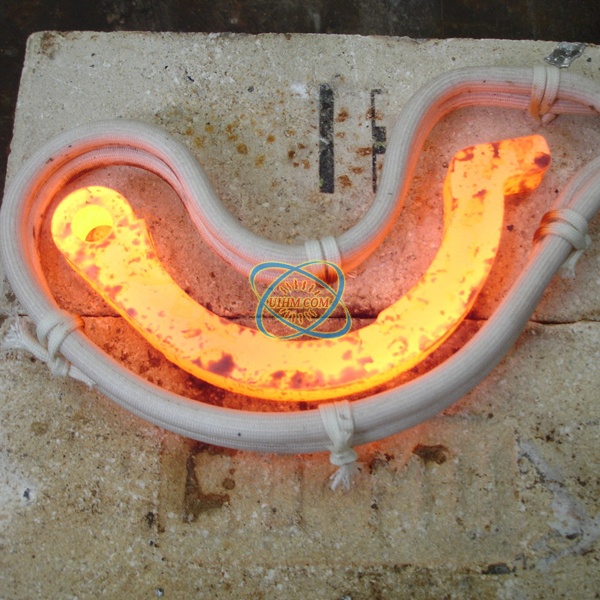
More Welders Resort to Induction Heating For Preheating, Stress-Relieving Traditional Induction Heating Applications – Soldering – Brazing – Surface hardening – Tempering- Bonding – Curing – Encapsulating- Melting- Forging- Super heating- Crystal growing Although many industries have used induction heating for decades, it’s a newcomer to industrial and construction applications involving welding. Pre-heating before welding and stress-relieving (i.e. postheating) after welding are the new uses for induction heating, and companies with weldiang-intensive operations have significantly increased efficiency as a result. Induction heating: how it works Induction heating systems employ non-contact heating. They induce heat electromagnetically rather than using a heating element in contact with a part to conduct heat, as does resistance heating. Induction heating acts more like a microwave oven; the appliance remains cool while the food cooks from within. In an industrial example of induction heating, heat is induced in the part by placing it in a high-frequency magnetic field. The magnetic field creates eddy currents inside the part, exciting the part’s molecules and generating heat. Because heating occurs slightly below the metal surface, no heat is wasted. Induction heating’s similarity to resistance heating is that conduction is required to heat through the section or part. The only difference is the source of heat and the temperatures of the tool. The induction process heats within the part and the resistance process heats on the surface of the part. Depth of heating depends on the frequency. High frequency (e.g., 50 khz), heats close to the surface, while low frequency (e.g., 60 Hz) penetrates deeper into the part, placing the heating source up to 3 mm deep, allowing heating of thicker parts. The induction coil does not heat-up because the conductor is large for the current being carried. In other words, the coil does not need to heat-up to heat the workpiece. Induction heating system components Induction heating systems can be air- or liquid-cooled depending on application requirements. A key component common to both systems is the induction coil used to generate heat within the part. Air-cooled system A typical air-cooled system consists of a power source (5kW or 25kW), induction blanket, and associated cables. The induction blanket consists of an induction coil surrounded by insulation and sewn into a high temperature, replaceable Kevlar sleeve. This type of induction system can include a controller to monitor and automatically control temperature. A system not equipped with a controller requires the use of a temperature indicator. The system could also include a remote on-off switch. Air-cooled systems can be used for applications up to 400 degrees F, designating it as a pre-heat only system. Liquid-cooled system Because liquid cools more efficiently than air, this type of induction heating system can be used for applications requiring higher temperatures, such as high-temperature preheating and stress relieving. The principle differences are the addition of a water cooler and the use of a flexible liquid-cooled hose that houses the induction coil. Liquid-cooled systems also generally use a temperature controller and built-in temperature recorder, particularly important components in stress relieving applications. The typical stress relieving procedure requires a step to 600-800 degrees F, followed by a ramp or controlled temperature rise to a soak temperature of approximately 1250 degrees F. After a hold time, the part is control-cooled to between 600-800 degrees F. The temperature recorder collects data on the part’s actual temperature profile based on a thermocouple input, a QA requirement for stress relieving applications. The actual procedure will be determined by the type of work and the applicable code. Induction heating benefits Compared to conventional preheating and stress relieving methods, induction heating offers numerous advantages, including improved heat uniformity and quality, reduced cycle time, and lower consumables costs. Induction heating is also safe, reliable and easy to use, and scores higher than alternative technologies in power efficiency and versatility.
Uniformity and quality Induction heating is not particularly sensitive to coil placement or spacing. Generally, the coils should be evenly spaced and centered on the weld joint. On systems so-equipped, a temperature controller can establish the power requirement in an analog fashion, providing just enough power to maintain the temperature profile. The power source provides power during the entire process. Reduced cycle time The induction method of preheating and stress relieving provides significantly quicker time-to-temperature. On thicker applications, such as high pressure steam lines, induction heating can slash two hours from cycle time. It is conceivable to reduce cycle time from the control temperature to soak temperature. When combined with other usability factors, it is not uncommon to expect a 50 percent total cycle time reduction. Reduced consumables costs The insulation used in induction heating is easy to attach to work pieces and can be reused many times. Conversely, ceramic fiber insulation used in resistance heating can be used only once or twice before it has to be discarded, requiring a large inventory of insulation and incurring significant costs for disposal of potentially hazardous material. In addition, in comparison to resistance system components, induction coils are robust and don’t require fragile wire or ceramic materials. Also, because the induction coils and connectors don’t operate at high temperatures, they are not subject to degradation, as are ceramic heating pads. Ease-of-use A major benefit of induction preheating and stress relieving is its simplicity, which contributes to easy use. Insulation and cables are simple to install, usually taking less than 15 minutes. UIHM has shown boilermakers and pipefitters how to use the induction equipment with just one day of training. Power efficiency The inverter power source is 92 percent efficient, a critical advantage in an era of skyrocketing energy costs. Additionally, the induction heating process is more than 80 percent efficient. Regarding power input, the induction process only requires a 40 amp line for 25kW of power. Safety Preheating and stress relieving through the induction method is extremely worker-friendly. Induction heating does not require hot heating elements and connectors. Very little airborne particulate is associated with the insulation blankets, and the insulation itself is not exposed to temperatures over 1800 degrees F, which can cause insulation to break down into dust and then breathed by workers . Reliability One of the most important factors impacting productivity in stress relieving is not interrupting the cycle. In most instances, cycle interruption means the heat treat will need to be re-run, which is significant when a thermal cycle can take a day to complete. The induction heating system components make cycle interruptions unlikely. The cabling for induction is simple, making it less likely to fail. Also, no contactors are used to control the heat input to the part. Versatility The Duolin Induction Heat Treatment System was originally designed for preheating and stress relieving of pipe. Now, users of induction heating systems have adapted the process for weldolets, elbows, valves, and other parts. One of the aspects of induction heating that makes it attractive for complex shapes is the ability to adjust the coils during the heating process to accommodate unique parts and heat sinks. The operator can start the process, determine the affects of the heating process in real-time and modify the coil position to change the result. Lastly, the induction cables can be moved without waiting for air cooling at the end of the cycle. Induction heating in welding applications DUO LIN Induction Heating Systems, Co, Ltd., the manufacturer of induction heating systems for welding applications, has proven its technology on a number of projects, including oil and gas pipelines, heavy equipment construction and maintenance and repair of mining equipment. Summaries of various projects are presented below. Oil pipeline A North American oil pipeline maintenance operation had used a combination of propane torches and electrical resistance to heat pipe before welding encirclement repair sleeves or STOPPLE fittings to the pipeline’s 48-inch girth. While many repairs could be made without having to stop oil flow or drain it from the pipe, the presence of the crude itself hampered welding efficiency due to the heat sink effect of the flowing oil. Propane torches required constant interruption of welding to maintain heat, and resistance heating – while providing continuous heat – often couldn’t meet required weld temperatures. The maintenance company turned to induction heating as a solution. On encirclement sleeve repairs, two 25kW systems were employed with parallel blankets to obtain a preheat temperature of 125 degrees F. As a result, cycle time was reduced from 8-12 hours to 4 hours per girth weld. Preheating for a STOPPLE fitting (a “T” junction with valve) repair had been even more challenging due to the fitting’s greater wall thickness. With induction heating however, the company used four 25kW systems with a paralleled blanket set-up. Two systems were used on each side of the “T”. One system was used on the mainline to preheat the oil and the second was used to preheat the “T” at the circumferential weld joint. The preheat temperature was 125 degrees F. The weld time was reduced from 12-18 hours to seven hours per girth weld. Natural gas pipeline A natural gas pipeline construction project entailed building a 36 in. diameter, .633 in. pipeline from Alberta, Canada to Chicago. On one spread of this pipeline, the welding contractor used two 25kW power sources mounted on a tractor with the induction blankets attached to booms for speed and convenience. The power sources were used to preheat both sides of the pipe joint. Critical to this process was speed and reliable temperature control. As alloy content increases in materials to reduce weight and weld time, and to increase part life, controlling preheat temperatures becomes more critical. In this induction heating application, it required less than three minutes to obtain the 250 degrees F preheat temperature, versus approximately five minutes using traditional preheating methods. In addition, temperature uniformity and operator safety were improved. Heavy Equipment A heavy equipment manufacturer often welds adapter teeth onto its loader bucket edges. Previously, the tack welded assembly was moved back and forth to a large furnace, requiring the welding operator to wait while the part was reheated repeatedly. The manufacturer opted to try induction heating to preheat the assembly to prevent movement of the product. The material is 4 in. thick with a high required preheat temperature due to alloy content. Duolin Electric worked with the customer to develop customized induction blankets to meet the application requirements. The insulation and coil design provided the added benefit of shielding the operator from the part’s radiant heat. Overall, operations were considerably more efficient, reducing welding time and maintaining temperature throughout the welding process. Mining equipment A mine had been experiencing cold cracking problems and preheating inefficiency using propane heaters in its repair operations of mining equipment. Welding operators had to remove a conventional insulating blanket from the thick part frequently to apply heat and keep the part at the correct temperature. The mine opted to try induction heating using flat, air-cooled blankets to preheat the parts before welding. The induction process applied heat to the part quickly. It also could be used continuously during the welding process. Weld repair time was reduced by 50 percent. In addition, the power source was equipped with a temperature controller to keep the part at the target temperature. This virtually eliminated rework due to cold cracking. The customer reported an annual savings of $80,000. Power plant A power plant builder was constructing a natural gas power facility in California. Boilermakers and pipefitters had been experiencing construction delays due to the preheating and stress relieving methods they were employing on the plant’s steam lines. One of the biggest problems on this job was reliability of the electrical resistance equipment, which suffered from contactor and connector failures and broken wires on the heating pads during stress relieving. Extensive rework as a result, combined with long heating cycles, was delaying construction significantly. The company brought in induction heating technology in an attempt to increase efficiency, particularly for work on medium to large steam lines, as these pieces take the most heat treating time required on a job site. On a typical 16 in. weldolet with a 2 in. wall thickness, resistance preheating and stress relieving used to take five-and-a-half hours to complete. Induction heating was able to shave two hours off the time-to-temperature (600 degrees F) and another hour to reach soak temperature (600 degrees F to 1350 degrees F) for stress relieving. The simplicity of wrapping the induction blankets around complex shapes further reduced the time to perform the heat treat. It took the fitters 15 minutes to wrap a joint that would have required two workers two hours to prepare using a resistance set-up
Related Content
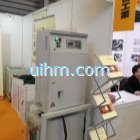
UIHM in laser photonics China expo
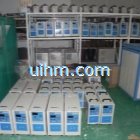
induction heaters in stock of UIHM
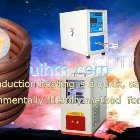
advantages of induction heating

Customers and exihibition of UIHM
HF induction heaters workshop tour of UIHM
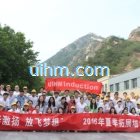
UIHM team 2016 Development Training in Beijing

2015 tour of riding horse in prairie of UM team
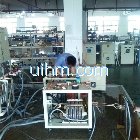
Induction heaters under testing in workshop

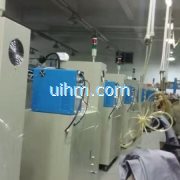
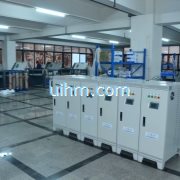
Newest Comment
No Comment
Post Comment